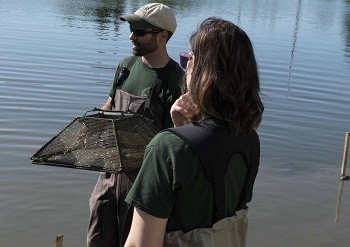State Awards $3.6 Million for Invasive Species Projects

Grant program marks 10 years of progress
The state of Michigan announced that 31 projects will share $3.6 million in grants through the Michigan Invasive Species Grant Program.
This cycle marks the MISGP’s 10th anniversary. To date, over $36 million has been awarded to support 269 projects undertaken by units of government, nonprofits and institutions.
The program – cooperatively implemented by the Michigan departments of Agriculture and Rural Development; Environment, Great Lakes, and Energy; and Natural Resources – addresses prevention, detection, eradication and control of aquatic (water-based) and terrestrial (land-based) invasive species in Michigan through four key objectives:
- Preventing the introduction of new invasive species.
- Strengthening the statewide invasive species early detection and response network.
- Limiting the spread of recently confirmed invasive species.
- Managing and controlling widespread, established invasive species.
“Over the last 10 years, the Michigan Invasive Species Grant Program has helped to build and sustain a statewide network of cooperative invasive species management areas, which fight invasive species in their local communities,” said DNR Director Scott Bowen “Grant-funded projects have increased public awareness and reporting of invasive species and supported a robust early detection and response program. This helps limit the introduction and spread of plants, animals and diseases that threaten the quality of Michigan’s land and water.”
Projects funded
Grant funds will support several early detection and response efforts for watch list invasive species:
- Continuing survey and treatment of hemlock woolly adelgid along the northern edge of the infestation in Benzie, Manistee and Mason counties along the Lake Michigan shoreline.
- Conducting surveys for hemlock woolly adelgid along the Lake Michigan shoreline in the Upper Peninsula.
- Evaluating current chemical treatment methods for hemlock woolly adelgid and assessing a potential nonchemical approach to managing the invasive insect.
- Conducting survey and treatment of invasive mile-a-minute weed infestations in Calhoun County.
- Broadening the survey for hydrilla, an invasive aquatic plant recently detected for the first time in Michigan in private ponds within the St. Joseph River watershed.
Funding also will support efforts to prevent the spread of invasive species:
- Performing invasive species assessment and planning for parks with natural areas in the city of Flint.
- Continuing to share theReduce Invasive Pet and PLant Escapes (RIPPLE) message and materials with retailers and hobbyists while expanding surrender options for unwanted aquatic plants and pets.
- Supporting continued public reporting of invasive species detections and a growing library of identification resources and training opportunities through the Midwest Invasive Species Information Network, housed at Michigan State University.
Support in every Michigan county
This year’s grants also support 22 regional cooperative invasive species management areas, the network of partnership organizations working to manage and control invasive species, serving all 83 counties in the state.
Each CISMA is eligible for $70,000 in annual support to provide education and technical assistance to landowners and up to $40,000 for tailored outreach and survey and treatment of high-priority invasive species. Grants to CISMAs represent nearly $1.8 million in 2024 ? approximately half of all MISGP awards.
10 years of progress
The program was initiated in 2014, when the state Legislature designated $5 million in annual funding to address invasive species, with $3.6 million earmarked for grants. This support substantially enhanced Michigan’s Invasive Species Program for aquatic organisms, supported a formal program for terrestrial species and initiated the Michigan Invasive Species Grant Program.
Because of this program:
- More than 644,000 acres of land and water have been surveyed for invasive species.
- More than 53,000 acres have been treated for invasive terrestrial and aquatic plants.
- Through direct contact, including face-to-face interactions at boat washes, workshops, trainings and other events, 395,000 people have been reached with information about invasive species.
- An additional 45 million contacts were achieved through grantees’ passive outreach efforts, including mail, newspapers, social media and handouts.
Over $8 million requested
The program began accepting grant applications for this funding cycle in September 2023. A total of 50 applications were received, requesting approximately $8.3 million in support.
The full list of grant recipients, project descriptions and award amounts is available on the Michigan Invasive Species Grant Program website at Michigan.gov/MISGP.
Michigan’s Invasive Species Program is cooperatively implemented by the Michigan departments of Agriculture and Rural Development; Environment, Great Lakes and Energy; and Natural Resources.






